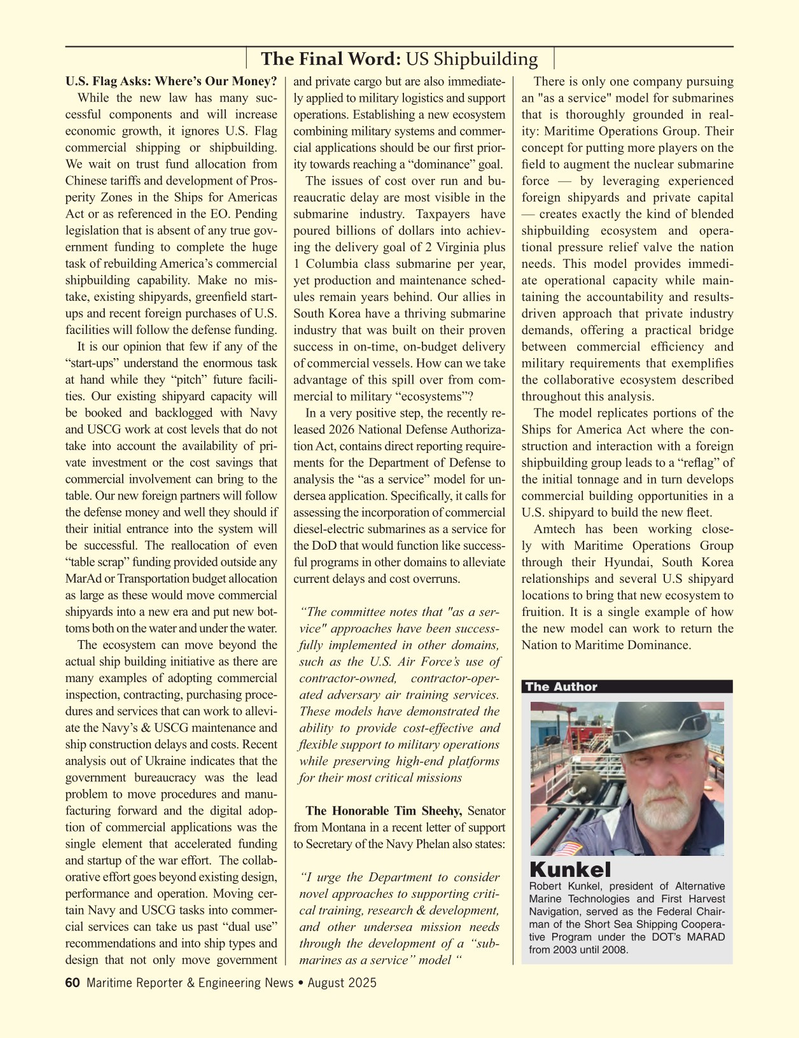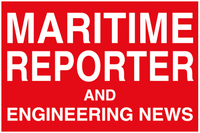
Page 60: of Maritime Reporter Magazine (August 2025)
Read this page in Pdf, Flash or Html5 edition of August 2025 Maritime Reporter Magazine
The Final Word: US Shipbuilding
U.S. Flag Asks: Where’s Our Money? and private cargo but are also immediate- There is only one company pursuing
While the new law has many suc- ly applied to military logistics and support an "as a service" model for submarines cessful components and will increase operations. Establishing a new ecosystem that is thoroughly grounded in real- economic growth, it ignores U.S. Flag combining military systems and commer- ity: Maritime Operations Group. Their commercial shipping or shipbuilding. cial applications should be our ? rst prior- concept for putting more players on the
We wait on trust fund allocation from ity towards reaching a “dominance” goal. ? eld to augment the nuclear submarine
Chinese tariffs and development of Pros- The issues of cost over run and bu- force — by leveraging experienced perity Zones in the Ships for Americas reaucratic delay are most visible in the foreign shipyards and private capital
Act or as referenced in the EO. Pending submarine industry. Taxpayers have — creates exactly the kind of blended legislation that is absent of any true gov- poured billions of dollars into achiev- shipbuilding ecosystem and opera- ernment funding to complete the huge ing the delivery goal of 2 Virginia plus tional pressure relief valve the nation task of rebuilding America’s commercial 1 Columbia class submarine per year, needs. This model provides immedi- shipbuilding capability. Make no mis- yet production and maintenance sched- ate operational capacity while main- take, existing shipyards, green? eld start- ules remain years behind. Our allies in taining the accountability and results- ups and recent foreign purchases of U.S. South Korea have a thriving submarine driven approach that private industry facilities will follow the defense funding. industry that was built on their proven demands, offering a practical bridge
It is our opinion that few if any of the success in on-time, on-budget delivery between commercial ef? ciency and “start-ups” understand the enormous task of commercial vessels. How can we take military requirements that exempli? es at hand while they “pitch” future facili- advantage of this spill over from com- the collaborative ecosystem described ties. Our existing shipyard capacity will mercial to military “ecosystems”? throughout this analysis.
be booked and backlogged with Navy In a very positive step, the recently re- The model replicates portions of the and USCG work at cost levels that do not leased 2026 National Defense Authoriza- Ships for America Act where the con- take into account the availability of pri- tion Act, contains direct reporting require- struction and interaction with a foreign vate investment or the cost savings that ments for the Department of Defense to shipbuilding group leads to a “re? ag” of commercial involvement can bring to the analysis the “as a service” model for un- the initial tonnage and in turn develops table. Our new foreign partners will follow dersea application. Speci? cally, it calls for commercial building opportunities in a the defense money and well they should if assessing the incorporation of commercial U.S. shipyard to build the new ? eet. their initial entrance into the system will diesel-electric submarines as a service for Amtech has been working close- be successful. The reallocation of even the DoD that would function like success- ly with Maritime Operations Group “table scrap” funding provided outside any ful programs in other domains to alleviate through their Hyundai, South Korea
MarAd or Transportation budget allocation current delays and cost overruns. relationships and several U.S shipyard as large as these would move commercial locations to bring that new ecosystem to shipyards into a new era and put new bot- “The committee notes that "as a ser- fruition. It is a single example of how toms both on the water and under the water. vice" approaches have been success- the new model can work to return the
The ecosystem can move beyond the fully implemented in other domains, Nation to Maritime Dominance. actual ship building initiative as there are such as the U.S. Air Force’s use of many examples of adopting commercial contractor-owned, contractor-oper-
The Author inspection, contracting, purchasing proce- ated adversary air training services. dures and services that can work to allevi- These models have demonstrated the ate the Navy’s & USCG maintenance and ability to provide cost-effective and ship construction delays and costs. Recent ? exible support to military operations analysis out of Ukraine indicates that the while preserving high-end platforms government bureaucracy was the lead for their most critical missions problem to move procedures and manu- facturing forward and the digital adop- The Honorable Tim Sheehy, Senator tion of commercial applications was the from Montana in a recent letter of support single element that accelerated funding to Secretary of the Navy Phelan also states: and startup of the war effort. The collab-
Kunkel orative effort goes beyond existing design, “I urge the Department to consider
Robert Kunkel, president of Alternative performance and operation. Moving cer- novel approaches to supporting criti-
Marine Technologies and First Harvest tain Navy and USCG tasks into commer- cal training, research & development,
Navigation, served as the Federal Chair- man of the Short Sea Shipping Coopera- cial services can take us past “dual use” and other undersea mission needs tive Program under the DOT’s MARAD recommendations and into ship types and through the development of a “sub- from 2003 until 2008.
design that not only move government marines as a service” model “ 60 Maritime Reporter & Engineering News • August 2025
MR #8 (50-61).indd 60 MR #8 (50-61).indd 60 8/4/2025 6:52:21 PM8/4/2025 6:52:21 PM

 59
59

 61
61
